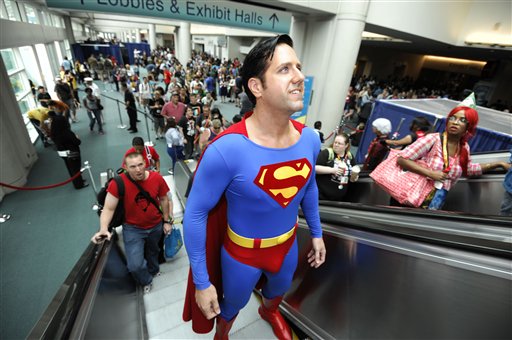
In a July 28 post, (www.popoptiq.com/will-we-ever-see-a-classic-superhero-movie/), my Sound on Sight colleague Deepayan Sengupta pondered the admittedly arguable premise that, for all their entertainment and box office value, the superhero movie has yet to provide a true cinematic classic. Back in March, I came at a vaguely similar idea but from a different angle (www.popoptiq.com/how-serious-can-a-comic-book-movie-be-discuss/). I suspected – as does Sengupta – that the problem could be that there might be some inherent barriers as to how far dramatic substance in the genre could be pushed: “…the form has limits, I think, more so than its printed source…and so does its core audience.”
As it happens, the July 27th issue of Entertainment Weekly offers their annual coverage of the San Diego Comic-Con which took place July 12-15. I think, in that coverage, possibly Sengupta and myself have our answer.
I’m sure most of the people who write or visit this site are better acquainted with Comic-Con than I am, but for you rare few who may be in the dark, let me borrow from reporter Adam B. Vary’s piece: “…(what) began in 1970 as a weekend-long hangout for a few hundred comic-book aficionados…has evolved into the single most important showcase for Hollywood’s biggest – and most expensive – projects.” According to Vary, over 125,000 fans packed the San Diego Convention Center for the granddaddy of comic book conventions.
Whatever individual Comic-Con fans are fans of – comic books, genre movies, TV shows, etc. – they’re unmatched in their rabid devotion. They come in costume, they remember franchise trivia even the creators have forgotten. Their bond with their idol of choice can be frightening in its intensity. And what they feel – about preview footage from an about-to-be released blockbuster, about a treasured TV classic, about a casting announcement for a new superhero franchise – they blog, tweet, text, Facebook, Skype, email about enthusiastically (good or bad) and relentlessly. Think of it: 125,000 Comic-Conians going back to their hotel rooms, campers, sidewalk tents each night to connect with their like-minded brothers and sisters all across the country (nay, the world!) through every social media pipeline there is to say, “See it as soon as it comes out! It’s gold!” Or, “Save your money; this one sucks the left hind one.”
As a result, by wide admission, Comic-Con has become so important to the Hollywood hype process that the comic book element of the convention – its initial reason for coming into being – has long since been eclipsed by movie and TV displays. The value of generating good buzz at Comic-Con is so recognized, that even projects which wouldn’t superficially seem a good fit with more representative fare — like panels for Twilight Saga: Breaking Dawn – Part 2 and the TV sci fi series Fringe – now share the convention floor i.e. AMC’s drug-fueled drama Breaking Bad, the Will Ferrell/Zach Galifianakis big screen political comedy The Campaign, and Quentin Tarantino’s vengeance Western, Django Unchained. Comic-Con is Hollywood’s version of Oprah’s Book Club; one good word and you’re a hit. That good word is worth crashing the door.
Actor Nathan Fillion – a Comic-Con idol for his role in the short-lived sci fi series Firefly – kept a diary of his experiences at this year’s gathering. One of his entries gives some idea of the kind of fan heat Comic-Con can produce.
Mind you, Firefly had fared so poorly in the ratings during its original run, it had been canceled by the Fox network after only 11 episodes. Yet, here was the series being saluted at this year’s Comic-Con with a 10-year anniversary panel. Fillion had seen a line outside the convention center: “…it winds back, forth, and back again and then winds under tents. I see the die-hards in their sleeping bags…I wonder what event they wait for, what piece of fandom do they anticipate?” It turns out they were at the convention for the Firefly panel. Wrote an emotional Fillion: “It’s hard to describe the feeling of vindication when your canceled TV show oversells the panel 10 years later, and by 20,000.”
It’s that kind of fan excitement which provides Comic-Con with its greatest strength, and which makes it invaluable to big-budget Hollywood…and which also provides the greatest danger to filmmakers tempted to follow Sengupta’s advice of trying for moviemaking classic status by breaking a few genre rules.
What the Comic-Con crowd feel, they feel with a passion and an awesome sense of collective identity – what Fillion describes as “…an energy of kinship…” Like or dislike, it’ll be a tidal wave of judgment sweeping out across the Internet.
Again, from Vary’s story: “There was no better proof of the power of Comic-Con than the moment during the Man of Steel (the Superman franchise reboot) panel when a grown man stepped to the mic to ask a question of director Zack Snyder and star Henry Cavill with tears streaming down his face.” The question? A rather routine one inquiring as to who the villain in the new movie might be. And for that: tears.
But an even better example of that same power – and how afraid filmmakers and studios and networks are of it – was a screening Peter Jackson held of 12 minutes from The Hobbit: An Unexpected Journey. Jackson screened the footage in conventional format; not in the new 48 frames-per-second digital format he’s been using to shoot the film. According to Jackson, he didn’t go with 48 fps because the convention center “…(isn’t) a real cinema.” But Jackson had screened footage from the movie at CinemaCon for movie business types in April in 48 fps, and the response had ranged from underwhelming to negative. I doubt the CinemaCon screening was any more a “real cinema” than Comic-Con, and it’s my suspicion that Jackson, after what happened at CinemaCon, felt that a similar response in San Diego would be lethal for a two-film project with a reported combined budget of around $500 million.
Here’s the statistical issue. One hundred and twenty-five thousand people is a lot of people at a convention; no doubt about it. And when they start social media-ing their observations, those 125,000 create a ripple effect that can easily translate into millions.
Yet, Firefly died in 11 episodes, and the 2005 big screen version – Serenity – which was supposed to capitalize on this fervent fan following, did only a meager $40 million worldwide. Or consider Fringe which has struggled in the ratings throughout its run even though it’s been another regular Comic-Con fave.
Comic-Con is like the presidential primaries. To gain the nomination, the candidate has to appeal to the party hard core, the ideologues. The rub is they don’t represent the less ideological, more centrist, more varied general electorate. In other words, everything you say, do, and promise to win the nomination can make you look like either a commie or a neo-Fascist in the general election.
Comic-Con represents the party faithful, the true believers. They are not the general movie audience. Most moviegoers don’t care whether or not Sam Raimi’s Spider-Man (2002) or Marc Webb’s The Amazing Spider-Man (2012) is closer to the classic comic book origin story. Most of them haven’t ever read a Spider-Man comic book. Past Peter Parker getting turned into a superhero by a bite from a funky spider, the Spider-Man canon is a big blank for them. The movie is either going to work for them as a movie, or it won’t.
What I’m saying is Comic-Con puts moviemakers and TV producers in a damned-if-you-do-damned-if-you-don’t bind. Winning over the Comic-Con crowd won’t win you the box office general election, but turning them off could very well lose it for you.
And how that plays out creatively is in an artistic conservatism. The Amazing Spider-Man is grand entertainment, and there are scenes between Andrew Garfield and Emma Stone that are startlingly charming. But there’s still gobs of action, and unless you’ve been hit in the head with a twenty pound sledgehammer, you know how this is going to come out: Spider-Man wins, The Lizard loses, Peter Parker and Gwen Stacy connect. Hell, you knew that when you bought the ticket.
Most superhero movies aren’t about challenging our expectations, but in living up to them, affirming them, fulfilling them. Like most genres, the superhero movie has its rituals, and violating those rituals brings risks, and with the hefty price tags that go with the typical superhero flick, “risk” is not a word a studio writing nine-figure checks wants to hear.
That’s the choke collar on the superhero movie. They are too big to fail, cost-wise, and a studio might let a filmmaker like Christopher Nolan push at the limits, maybe even put a toe over them, but that $250 million The Dark Knight Rises is still going to have a clearly evil super-villain, tons of incredible action, and more or less touch most of the superhero bases (if with unmatchable deftness).
There was a time when rule-breaking risks – and I mean clean, through-the-rails breaks — were encouraged, where the surprise of taking the familiar into unfamiliar territory turned out – here’s that word – classics. Rick doesn’t get the girl and that’s what makes Casablanca (1942) so poignant even 70 years later. The big, soapy melodrama that’s Gone with the Wind (1939) crackles like lightning when Rhett Butler, after chasing Scarlett O’Hara for three hours, gets fed up and tells her to kiss his ass (well, actually he says, “Frankly, my dear, I don’t give a damn,” but that’s what he meant). Not only does astronaut Taylor not escape from the Planet of the Apes (1968), but he finds out – in one of the most iconic final shots in American movies — that that’s was left of his nuke-torched home. The Wild Bunch (1969) learn that with the Old West overrun with civilization, their only option is a form of glorious suicide. The French Connection’s (1971) Popeye Doyle busts the biggest heroin ring in U.S. history, but the ringleader escapes, and, in trying to nail him, Doyle winds up accidentally shooting another cop. Private eye J. J. Gittes finds himself at the end of Chinatown (1974) with his girlfriend dead, her killer – her incestuous, morally bankrupt father – going free with her daughter in his arms.
Not all classics have to break rules, not all classics need to end tragically. What they typically have in common is an allegiance to their own nature: they go where they should go. As long as Hollywood keeps running movies and TV shows through gauntlets like Comic-Con and feels (understandably, I should say, considering the money at stake) compelled to satisfy instead of challenge, the chances of a classic are slim.
Bill Mesce




